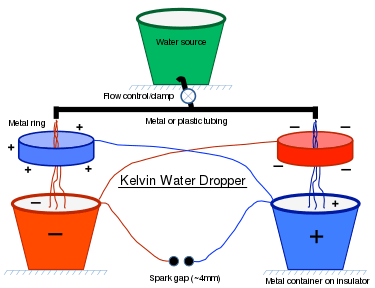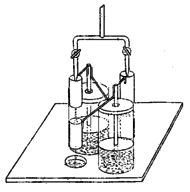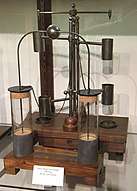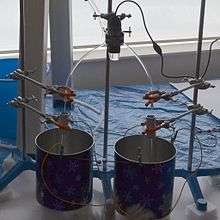Kelvin water dropper
The Kelvin water dropper, invented by Scottish scientist William Thomson (Lord Kelvin) in 1867,[1] is a type of electrostatic generator. Kelvin referred to the device as his water-dropping condenser. The apparatus is variously called the Kelvin hydroelectric generator, the Kelvin electrostatic generator, or Lord Kelvin's thunderstorm. The device uses falling water to generate voltage differences by electrostatic induction occurring between interconnected, oppositely charged systems. This eventually leads to an electric arc discharging in the form of a spark. It is used in physics education to demonstrate the principles of electrostatics.

Description
A typical setup is shown in Fig. 1. A reservoir of water or other conducting liquid (top, green) is connected to two hoses that release two falling streams of drops, which land in two buckets or containers (bottom, blue and red). Each stream passes (without touching) through a metal ring or open cylinder which is electrically connected to the opposite receiving container; the left ring (blue) is connected to the right bucket, while the right ring (red) is connected to the left bucket. The containers must be electrically insulated from each other and from electrical ground. Similarly, the rings must be electrically isolated from each other and their environment. It is necessary for the streams to break into separate droplets before reaching the containers. Typically, the containers are made of metal and the rings are connected to them by wires.
The simple construction makes this device popular in physics education as a laboratory experiment for students.
Principles of operation



A small initial difference in electric charge between the two buckets, which always exists because the buckets are insulated from each other, is necessary to begin the charging process. Suppose, therefore, that the right bucket has a small positive charge. Now the left ring also has some positive charge because it is connected to the bucket. The charge on the left ring will attract negative charges in the water (ions) into the left-hand stream by the Coulomb electrostatic attraction. When a drop breaks off the end of the left-hand stream, the drop carries a negative charge with it. When the negatively charged water drop falls into its bucket (the left one), it gives that bucket and the attached ring (the right one) a negative charge.
Once the right ring has a negative charge, it similarly attracts positive charge into the right-hand stream. When drops break off the end of that stream, they carry positive charge to the positively charged bucket, making that bucket even more positively charged.
Thus positive charges are attracted to the right-hand stream by the ring, and positive charge drips into the positively charged right bucket. Negative charges are attracted to the left-hand stream and negative charge drips into the negatively charged left bucket. This process of charge separation that occurs in the water is called electrostatic induction. The higher the charge that accumulates in each bucket, the higher the electrical potential on the rings and the more effective this process of electrostatic induction is.[2] During the induction process, there is an electric current that flows in the form of positive or negative ions in the water of the supply lines. This is separate from the bulk flow of water that falls through the rings and breaks into droplets on the way to the containers. For example, as water approaches the negatively charged ring on the right, any free electrons in the water can easily flee toward the left, against the flow of water.
Eventually, when both buckets have become highly charged, several different effects may be seen. An electric spark may briefly arc between the two buckets or rings, decreasing the charge on each bucket. If there is a steady stream of water through the rings, and if the streams are not perfectly centered in the rings, one can observe the deflection of the streams prior to each spark due to the electrostatic attraction via Coulomb's law of opposite charges.[3] As charging increases, a smooth and steady stream may fan out due to self-repulsion of the net charges in the stream. If the water flow is set such that it breaks into droplets in the vicinity of the rings, the drops may be attracted to the rings enough to touch the rings and deposit their charge on the oppositely charged rings, which decreases the charge on that side of the system. In that case also, the buckets will start to electrostatically repel the droplets falling towards them, and may fling the droplets away from the buckets. Each of these effects will limit the voltage that can be reached by the device. The voltages reached by this device can be in the range of kilovolts, but the amounts of charge are small, so there is no more danger to persons than that of static electrical discharges produced by shuffling feet on a carpet, for example.
The opposite charges which build up on the buckets represent electrical potential energy, as shown by the energy released as light and heat when a spark passes between them. This energy comes from the gravitational potential energy released when the water falls. The charged falling water drops do work against the opposing electric field of the like-charged containers, which exerts an upward force against them, converting gravitational potential energy into electrical potential energy, plus motional kinetic energy. The kinetic energy is wasted as heat when the water drops land in the buckets, so when considered as an electric power generator the Kelvin machine is very inefficient. However, the principle of operation is the same as with other forms of hydroelectric power. As always, energy is conserved.
Details

If the buckets are metal conductors, then the built-up charge resides on the outside of the metal, not in the water. This is part of the electrical induction process, and is an example of the related "Faraday's ice bucket." Also, the idea of bringing small amounts of charge into the center of a large metal object with a large net charge, as happens in Kelvin's water dropper, relies on the same physics as in the operation of a van de Graaff generator.
The discussion above is in terms of charged droplets falling. The inductive charging effects occur while the water stream is continuous. This is because the flow and separation of charge occurs already when the streams of water approach the rings, so that when the water passes through the rings there is already net charge on the water. When drops form, some net charge is trapped on each drop as gravity pulls it toward the like-charged container.
When the containers are metal, the wires may be attached to the metal. Otherwise, the container-end of each wire must dip into the water. In the latter case, the charge resides on the surface of the water, not outside of the containers.
The apparatus can be extended to more than two streams of droplets.[4]
In 2013, a combined group from the University of Twente (the Netherlands) constructed a microfluidic version of the Kelvin water dropper, which yields electrical voltages able to charge, deform and break water droplets of micrometric size by just using pneumatic force instead of gravity.[5] A year later, they developed another version of microfluidic Kelvin water dropper,[6] using microscale liquid jet (then break into microdroplets) shooting on a metal target, which yields maximum 48% efficiency.[7]
References
- Thomson, William (November 1867). "On a self-acting apparatus for multiplying and maintaining electric charges, with applications to the Voltaic Theory". The London, Edinburgh, and Dublin Philosophical Magazine and Journal of Science. Series 4. 34 (231): 391–396. Retrieved September 1, 2015.
- "Kelvin Water Dropper activity". CSIRO. Archived from the original on 2005-02-08. Retrieved 2009-01-07.
- Maryam Zaiei-Moayyed; Edward Goodman; Peter Williams (November 2000). "Electrical deflection of polar liquid streams: A misunderstood demonstration". Journal of Chemical Education. 77 (11): 1520–1524. Bibcode:2000JChEd..77.1520Z. doi:10.1021/ed077p1520.
- Markus Zahn, "Self-excited a.c. high voltage generation using water droplets," American Journal of Physics, vol. 41, pages 196-202 (1973).
- Alvaro G. Marin et al.,"The microfluidic Kelvin water dropper". Lab on a chip (DOI: 10.1039/C3LC50832C). (https://arxiv.org/abs/1309.2866).
- Y.Xie et al., "Pressure-driven ballistic Kelvin's water dropper for energy harvesting. ". "Lab on a chip"(DOI: 10.1039/C4LC00740A).
- Y.Xie et al., "High-efficiency ballistic electrostatic generator using microdroplets". "Nature Communications"(DOI:10.1038/ncomms4575).
External links
- YouTube ("Reinhard Schumacher") - Kelvin Water Dropper: Implementation and Explanation
- YouTube ("RimstarOrg") - Kelvin Water Dropper and How it Works
- YouTube ("Veritasium") - Sparks from Falling Water: Kelvin's Thunderstorm
- Detailed description of device and how to build your own Kelvin water dropper.
- Lego Kelvin water dropper